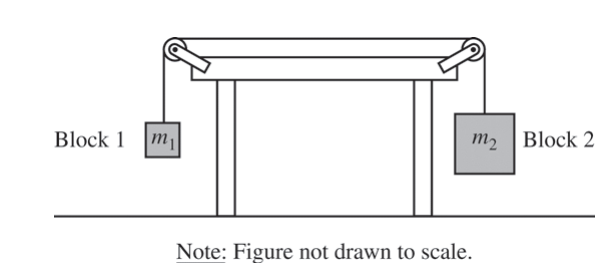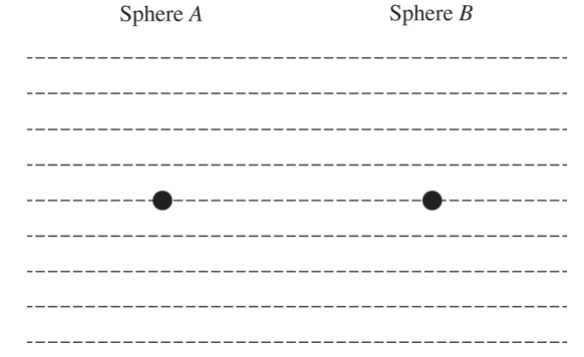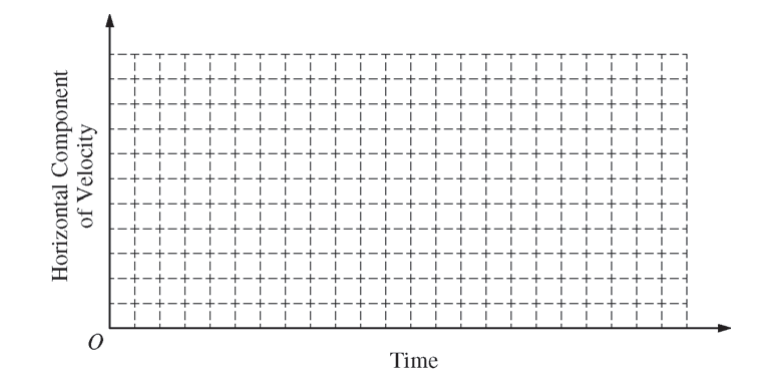Question: (7 points, suggested time 13 minutes)

Two blocks are connected by a string of negligible mass that passes over massless pulleys that turn with negligible friction, as shown in the figure above. The mass m2 of block 2 is greater than the mass m1 of block 1. The blocks are released from rest.
(a) The dots below represent the two blocks. Draw free-body diagrams showing and labeling the forces (not components) exerted on each block. Draw the relative lengths of all vectors to reflect the relative magnitudes of all the forces.

(b) Derive the magnitude of the acceleration of block 2. Express your answer in terms of m1 , m2 , and g.
Block 3 of mass m3 is added to the system, as shown below. There is no friction between block 3 and the table.

(c) Indicate whether the magnitude of the acceleration of block 2 is now larger, smaller, or the same as in the original two-block system. Explain how you arrived at your answer.
▶️Answer/Explanation
Ans:
(a) 
(b) According to Newton’s Second Law
For block 2: m2g – FT’ = m2.a
For block 1: Ft – m1g = m1.a.
According to Newton’s 3rd Law = |FT| = |FT’|
∴ m2g – m1g = m2a + m1a.
∴\(a^{2}=\frac{\left ( m_{2}-m_{1} \right )g}{m_{1}+m_{2}}\)
(c) a2 = a system = \(\frac{\left ( m_{2}-m_{1} \right )g}{m_{1}+m_{2}+m_{3}}< \frac{\left ( m_{2}-m_{1} \right )g}{m_{1}+m_{2}}=a_{2} original\)
∴ the acceleration now is smaller than that before due to the increase in the total mass of the system.
Question: (7 points, suggested time 13 minutes)

Two identical spheres are released from a device at time t = 0 from the same height H, as shown above. Sphere A has no initial velocity and falls straight down. Sphere B is given an initial horizontal velocity of magnitude v0 and travels a horizontal distance D before it reaches the ground. The spheres reach the ground at the same time tf , even though sphere B has more distance to cover before landing. Air resistance is negligible.
(a) The dots below represent spheres A and B. Draw a free-body diagram showing and labeling the forces (not components) exerted on each sphere at time \(\frac{t_{f}}{2}.\)

(b) On the axes below, sketch and label a graph of the horizontal component of the velocity of sphere A and of sphere B as a function of time.

(c) In a clear, coherent, paragraph-length response, explain why the spheres reach the ground at the same time even though they travel different distances. Include references to your answers to parts (a) and (b).
▶️Answer/Explanation
Ans:
(a)

(b)

(c)
Reaching the ground from the table concerns only vertical distance. Thus, the only component of velocity that impacts the time to reach the ground is the y component of velocity. The X-component makes a ball travel farther horizontally during the same time, but it won’t make it fall at a faster speed toward the ground. This can also be shown using the following Kinematic equation:
\(y = y_{0}+y_{g0}t.\frac{1}{2}a_{g}t^{2}\)
y final and y0 are the same for both spheres because they start and end at the same heights. The initial y component of velocity is zero for both spheres. Acceleration is also equal, for gravely is the only think acting on the spheres in the vertical direction. Thus, the time if takes for the spheres to reach the ground must be equal.
Question: (12 points, suggested time 25 minutes)
A student wants to determine the coefficient of static friction between a long, flat wood board and a small wood block.
(a) Describe an experiment for determining the coefficient of static friction between the wood board and the wood block. Assume equipment usually found in a school physics laboratory is available.
i. Draw a diagram of the experimental setup of the board and block. In your diagram, indicate each quantity that would be measured and draw or state what equipment would be used to measure each quantity.
ii. Describe the overall procedure to be used, including any steps necessary to reduce experimental uncertainty. Give enough detail so that another student could replicate the experiment.
(b) Derive an equation for the coefficient of static friction in terms of quantities measured in the procedure from part (a).
A physics class consisting of six lab groups wants to test the hypothesis that the coefficient of static friction between the board and the block equals the coefficient of kinetic friction between the board and the block. Each group determines the coefficients of kinetic and static friction between the board and the block. The groups’ results are shown below, with the class averages indicated in the bottom row.
| Lab Group Number | Coefficient of Kinetic Friction | Coefficient of Static Friction |
| 1 | 0.45 | 0.54 |
| 2 | 0.46 | 0.52 |
| 3 | 0.42 | 0.56 |
| 4 | 0.43 | 0.55 |
| 5 | 0.74 | 0.23 |
| 6 | 0.44 | 0.54 |
| Average | 0.49 | 0.49 |
(c) Based on these data, what conclusion should the students make about the hypothesis that the coefficients of static and kinetic friction are equal?
____ The static and kinetic coefficients are equal.
____ The static and kinetic coefficients are not equal.
Briefly justify your reasoning.
(d) A metal disk is glued to the top of the wood block. The mass of the block-disk system is twice the mass of the original block. Does the coefficient of static friction between the bottom of the block and the board increase, decrease, or remain the same when the disk is added to the block?
___ _ Increase ____ Decrease ____ Remain the same
Briefly state your reasoning.
▶️Answer/Explanation
Ans:
(a)
i. 
The force reavired to set the block in motion and the mass of the block would be measured.
ii. The student would first connect a force sensor to the logger pro interfacwe, next the scale would be used to find the mass of the small block. This block would the be placed on the Board and the student would connect a force sensor, Then using the force sensor a small increasing amount of force would be applied until the block is set in motion. This force would be recorded.
(b)  \(\sum = ma\) Ff ≤ NNf
\(\sum = ma\) Ff ≤ NNf
Nf
Nf = m9
F5 = F Nfu = F
M9u = F
\(\frac{M9}{F} = u\)
(c)
__√__ The static and kinetic coefficients are not equal.
The data points in group 5 are an outliner and should be retested If these data points are not used the averages are Fk = .44 and Fs = .54
(d)
__√__ Remain the same
The frictional force can be defined as μsN = Fs When the disk is added the Normal force increases but the coefficient of friction stays the same. coefficients of friction deal with the types of surfaces rubbing together not the wieght.
